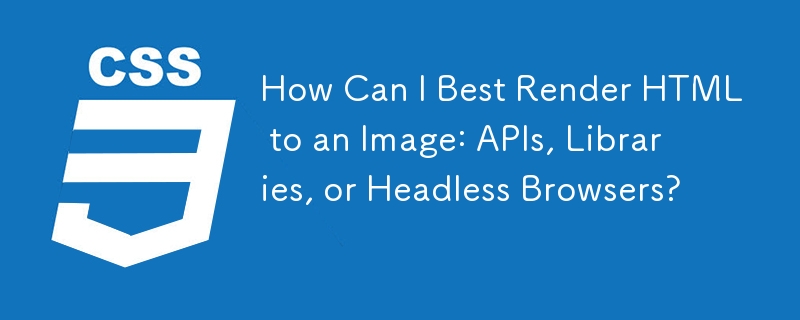 Web Front-end
Web Front-end
 CSS Tutorial
CSS Tutorial
 How Can I Best Render HTML to an Image: APIs, Libraries, or Headless Browsers?
How Can I Best Render HTML to an Image: APIs, Libraries, or Headless Browsers?
How Can I Best Render HTML to an Image: APIs, Libraries, or Headless Browsers?
Dec 28, 2024 am 04:31 AM
Render HTML to an Image: A Comprehensive Guide
Converting HTML to an image format like PNG can be a challenge. While canvas offers a rudimentary approach, it falls short when it comes to rendering standard HTML elements. Here are several options that address this need with varying advantages and drawbacks:
1. API Solutions
Pros:
- JavaScript execution
- Near-perfect rendering
- Fast (with caching)
- Scale management
- Precise control
Cons:
- Paid for extensive usage
Examples:
- ApiFlash
- EvoPDF
- Grabzit
- HTML/CSS to Image API
2. Browser Rendering Libraries
Pros:
- Relatively quick conversion
Cons:
- Poor rendering quality
- No JavaScript execution
- Limited support for modern web features
- Installation and scaling difficulties
Examples:
- dom-to-image
- wkhtmltoimage
- IMGKit (Ruby wrapper)
3. PhantomJS with Wrappers
Pros:
- JavaScript execution
- Relatively quick
Cons:
- Poor rendering quality
- Limited support for modern web features
- Scaling and compatibility challenges
Examples:
- PhantomJS
- node-webshot
4. Chrome Headless with Wrappers
Pros:
- JavaScript execution
- Near-perfect rendering
Cons:
- Precise control difficulties
- Scalability challenges
- Slowness, especially with external links
Examples:
- Chrome Headless
- chrome-devtools-protocol
- Puppeteer (JavaScript wrapper)
Option Recommendations:
- For precise rendering and extensive control: ApiFlash, EvoPDF, or similar API solutions.
- For higher speed at the cost of rendering quality: dom-to-image, wkhtmltoimage, or their wrappers.
- For a balance between speed and quality: PhantomJS or Chrome Headless with careful configuration.
Disclosure: The author is the founder of ApiFlash. This answer aims to provide an unbiased evaluation of available options.
The above is the detailed content of How Can I Best Render HTML to an Image: APIs, Libraries, or Headless Browsers?. For more information, please follow other related articles on the PHP Chinese website!

Hot AI Tools

Undress AI Tool
Undress images for free

Undresser.AI Undress
AI-powered app for creating realistic nude photos

AI Clothes Remover
Online AI tool for removing clothes from photos.

Clothoff.io
AI clothes remover

Video Face Swap
Swap faces in any video effortlessly with our completely free AI face swap tool!

Hot Article

Hot Tools

Notepad++7.3.1
Easy-to-use and free code editor

SublimeText3 Chinese version
Chinese version, very easy to use

Zend Studio 13.0.1
Powerful PHP integrated development environment

Dreamweaver CS6
Visual web development tools

SublimeText3 Mac version
God-level code editing software (SublimeText3)

Hot Topics
 What is 'render-blocking CSS'?
Jun 24, 2025 am 12:42 AM
What is 'render-blocking CSS'?
Jun 24, 2025 am 12:42 AM
CSS blocks page rendering because browsers view inline and external CSS as key resources by default, especially with imported stylesheets, header large amounts of inline CSS, and unoptimized media query styles. 1. Extract critical CSS and embed it into HTML; 2. Delay loading non-critical CSS through JavaScript; 3. Use media attributes to optimize loading such as print styles; 4. Compress and merge CSS to reduce requests. It is recommended to use tools to extract key CSS, combine rel="preload" asynchronous loading, and use media delayed loading reasonably to avoid excessive splitting and complex script control.
 External vs. Internal CSS: What's the Best Approach?
Jun 20, 2025 am 12:45 AM
External vs. Internal CSS: What's the Best Approach?
Jun 20, 2025 am 12:45 AM
ThebestapproachforCSSdependsontheproject'sspecificneeds.Forlargerprojects,externalCSSisbetterduetomaintainabilityandreusability;forsmallerprojectsorsingle-pageapplications,internalCSSmightbemoresuitable.It'scrucialtobalanceprojectsize,performanceneed
 Does my CSS must be on lower case?
Jun 19, 2025 am 12:29 AM
Does my CSS must be on lower case?
Jun 19, 2025 am 12:29 AM
No,CSSdoesnothavetobeinlowercase.However,usinglowercaseisrecommendedfor:1)Consistencyandreadability,2)Avoidingerrorsinrelatedtechnologies,3)Potentialperformancebenefits,and4)Improvedcollaborationwithinteams.
 CSS Case Sensitivity: Understanding What Matters
Jun 20, 2025 am 12:09 AM
CSS Case Sensitivity: Understanding What Matters
Jun 20, 2025 am 12:09 AM
CSSismostlycase-insensitive,butURLsandfontfamilynamesarecase-sensitive.1)Propertiesandvalueslikecolor:red;arenotcase-sensitive.2)URLsmustmatchtheserver'scase,e.g.,/images/Logo.png.3)Fontfamilynameslike'OpenSans'mustbeexact.
 What is Autoprefixer and how does it work?
Jul 02, 2025 am 01:15 AM
What is Autoprefixer and how does it work?
Jul 02, 2025 am 01:15 AM
Autoprefixer is a tool that automatically adds vendor prefixes to CSS attributes based on the target browser scope. 1. It solves the problem of manually maintaining prefixes with errors; 2. Work through the PostCSS plug-in form, parse CSS, analyze attributes that need to be prefixed, and generate code according to configuration; 3. The usage steps include installing plug-ins, setting browserslist, and enabling them in the build process; 4. Notes include not manually adding prefixes, keeping configuration updates, prefixes not all attributes, and it is recommended to use them with the preprocessor.
 What are CSS counters?
Jun 19, 2025 am 12:34 AM
What are CSS counters?
Jun 19, 2025 am 12:34 AM
CSScounterscanautomaticallynumbersectionsandlists.1)Usecounter-resettoinitialize,counter-incrementtoincrease,andcounter()orcounters()todisplayvalues.2)CombinewithJavaScriptfordynamiccontenttoensureaccurateupdates.
 CSS: When Does Case Matter (and When Doesn't)?
Jun 19, 2025 am 12:27 AM
CSS: When Does Case Matter (and When Doesn't)?
Jun 19, 2025 am 12:27 AM
In CSS, selector and attribute names are case-sensitive, while values, named colors, URLs, and custom attributes are case-sensitive. 1. The selector and attribute names are case-insensitive, such as background-color and background-Color are the same. 2. The hexadecimal color in the value is case-sensitive, but the named color is case-sensitive, such as red and Red is invalid. 3. URLs are case sensitive and may cause file loading problems. 4. Custom properties (variables) are case sensitive, and you need to pay attention to the consistency of case when using them.
 Case Sensitivity in CSS: Selectors, Properties, and Values Explained
Jun 19, 2025 am 12:38 AM
Case Sensitivity in CSS: Selectors, Properties, and Values Explained
Jun 19, 2025 am 12:38 AM
CSSselectorsandpropertynamesarecase-insensitive,whilevaluescanbecase-sensitivedependingoncontext.1)Selectorslike'div'and'DIV'areequivalent.2)Propertiessuchas'background-color'and'BACKGROUND-COLOR'aretreatedthesame.3)Valueslikecolornamesarecase-insens





